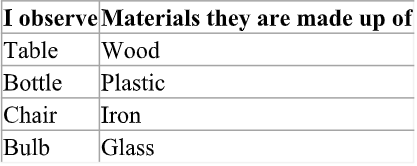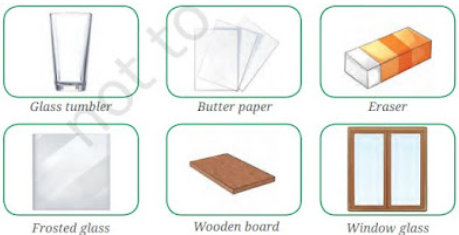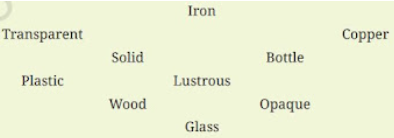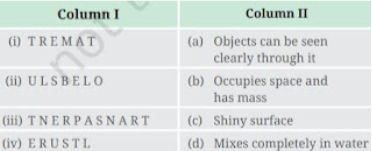NCERT Solutions for Ch 6 Materials Around Us Class 6 Science
Book Solutions1

Answer

2

Answer
Materials which can be used to make tumbler:
• Glass
• Clay
• Iron
• Plastic
• Bamboo
• Aluminium
• Steel
• Copper
3
Answer
No, it is not a good idea to use paper like materials for making utensils as the paper will get burnt under high temperature and flame. Also, it will get wet due the liquid content of food.4
Answer
Tumbler cannot be made of cloth for storing water because the cloth is porous and water will pass through it. Cloth is not able to store water.5

Answer
• Transparent:Glass tumbler, Window glass• Translucent:Butter paper, Frosted glass
• Opaque: Eraser, Wooden board
6
Answer
Yes, water in its natural form is transparent. It can be made opaque by dissolving other materials like mud, colour etc.7
Answer
No, everything we put in water does not disappear. Only the materials which are soluble in water disappear when mixed with water in limited amount.8
Answer
Properties like mass and volume is shown by all materials.9

Answer
Glass → TransparentWood → Opaque
Iron → Lustrous
Bottle → Plastic
Copper → Solid
10
The following words from the chapter like lustrous, nonlustrous, soluble, insoluble, hard, soft, matter, mass, transparent, opaque, volume and translucent are picked up.

• Then, the facilitator either reads the definition of a word or the word itself (randomly) from the given list.
• The learners have to tick if the particular word is there in the grid.
• Whoever finishes ticking off all nine words first will shout out ‘Hurray!’. That person will be the winner if his/her words are marked correctly
Answer

• Non-lustrous:These materials do not have shiny surfaces and have dull appearance.
• Soluble: Substances which get dissolved in water.
• Insoluble: Substances which do not get dissolved in water.
• Mass: It is the amount of the substance contained in an object.
• Volume: The space occupied by matter is its volume.
• Matter: Anything that occupies space and has mass.
• Transparent: Materials through which things can be seen clearly and light can pass completely through them are known as transparent substance.
• Opaque: Materials through which we are not able to see and light cannot pass through them are known as opaque materials.
• Translucent: Materials through which objects can be seen but not clearly and light can partially pass through them are known as translucent materials.
• Hard: Material which is difficult to compress or scratch is called hard.
• Soft: Material which can be compressed or scratched easily is called soft.
11
Answer
Some suggestions for organising kitchen edibles in a better way are:
i Group items by type to make it easier to find similar items together.
ii Place frequently used items like salt, sugar, oil, within reach or on easy accessible shelves.
iii Place less-used items on higher shelves or toward the back.
iv Use transparent containers and label them to easily identify contents.
12

Answer

13
Answer
Containers used to store materials in shops and at home are often transparent to make it easy to identify the contents inside the containers.14
(i) Wood is translucent while glass is opaque. [ ]
(ii) Aluminium foil has lustre while an eraser does not. [ ]
(iii) Sugar dissolves in water whereas sawdust does not. [ ]
(iv) An apple is a matter because it occupies no space and has mass. [ ]
Answer
(i) Wood is translucent while glass is opaque. False [F]Correct Statement: Wood is opaque while glass is translucent.
(ii) Aluminium foil has lustre while an eraser does not. True [T]
(iii) Sugar dissolves in water whereas sawdust does not. True [T]
(iv) An apple is a matter because it occupies no space and has mass. False [F]
Correct Statement: An apple is a matter as it occupies space and has mass.
15
We see chairs made up of various materials, such as wood, iron, plastic, bamboo, cement and stones. Following are some desirable properties of materials which can be used to make chairs. Which materials used to make chairs fulfil these properties the most?
(i) Hardness (does not bend or shake on sitting even after long use).
(ii) Lightweight (easy to lift or to take from one place to another).
(iii) Does not feel very cold when sitting during winters.
(iv) Can be cleaned regularly and made to look new even after long use.
Answer
(i) Iron, Cement, Stones.(ii) Plastic, Bamboo.
(iii) Wood and bamboo chairs does not feel very cold when sitting during winters.
(iv) Plastic and iron chairs can be cleaned regularly and made to look new even after long use.
16
You need to have containers for collection of:
(i) food waste,
(ii) broken glass and
(iii) wastepaper.
Which materials will you choose for containers of these types of waste? What properties of materials do you need to think of?
Answer
(i) Food waste: Plastic or metal containers are ideal for storing food waste because they are durable, resistant to corrosion and easy to clean.(ii) Broken glass: Metal or hard plastic containers should be used for collecting broken glass due to their durability and toughness.
(iii) Wastepaper: Light weight plastic or cardboard containers work well for collecting wastepaper.
17
Air is all around us but does not hinder us from seeing each other.
Whereas, if a wooden door comes in between, we cannot see each other. It is because air is _____ and the wooden door is ______.
Choose the most appropriate option:
(i) transparent, opaque
(ii) translucent, transparent
(iii) opaque, translucent
(iv) transparent, translucent
Answer
(i) transparent, opaque
Air is all around us but does not hinder us from seeing each other. Whereas, if a wooden door comes in between, we cannot see each other. It is because air is transparent and the wooden door is opaque.
18
Answer
• Material X:Likely a hard soluble solid e.g. salt, sugar.
• Material Y:Likely a soft insoluble material e.g. clay, rubber.
Material X is hard because it retains its shape under pressure and is likely a solid that dissolves in water.
Material Y is soft because it changes shape easily when pressed and it does not dissolve in water.